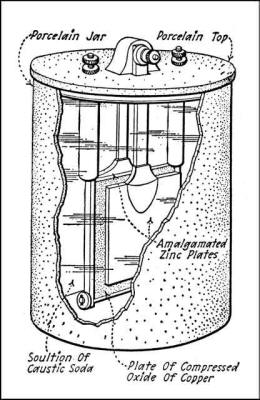asbestos stone, which has no fire of its own, and yet, when it has received fire, blazes so fiercely with a fire not its own that it cannot be quenched.
The sources from which our knowledge of Assyrian Chemistry is obtained are a very small part of the collections of cuneiform tablets in our museums, which may perhaps be reckoned at a quarter of a million roughly in number, and of this chemistry, almost all our knowledge comes from tablets of the Seventh Century B.C.
The value of this discovery increases when one knows that four similar clay vases were found near TelOmar or Seleukia – three of them containing copper cylinders similar to the one found at Khujut Rabua. The Seleukia finds were, apparently, less well preserved – there are no iron rods in evidence any more. But close to those four vases pieces of thinner iron and copper rods were found which might be assumed to have been used as conductive wires.
By 650 B.C. the list of chemicals may be said to include Common Salt, Sal gemma, red Sal Gemma, Lime, Saltpeter from the earth, Carbonate of Soda from the walls, Nitrate of Potash from walls, Sal Ammoniac from plants, Gypsum, Mercury from cinnabar, Alum, Black and Yellow Sulphur, Bitumen, various forms of Arsenic, red and black Copper Oxide, Chrysocolla, Haematite, Magnetic Iron Ore, Iron Pyrites (which leads to Vitriols), Iron Sulphide, Copper Sulphate; and if I am right, they had a word hannabahru for the fuming sulphuric acid from Green Vitriol.[vi]
An arc light from the collection of Larry Brian Radka
However, beside the materials already mentioned, using glass, lead, zinc, and some types of electrolytes like caustic soda and sulfuric acid produce stronger types of non-rechargeable Bagdad-types of primary batteries – as well as powerful rechargeable storage or secondary batteries that could have been used for ancient electric lighting.
How could this be – when the ancient Egyptians emblazoned on their monuments almost every other important innovation that shaped their daily lives? Perhaps, like a more contemporary authority, Robert Temple,[ix]observed, concerning all the previously unrecognized ancient lenses stashed away in the worlds museums, the answer lies in the fact that people are not looking for ancient electric lights so they simply do not recognize them.
The lower end of the copper cylinder was covered with a piece of sheet copper, the same thickness and quality as the cylinder itself.
Arculf(Arculfus), a Frankish bishop, perhaps of Prigueux, who visited and explored the Holy Land, accompanied by Peter, a Bergundian monk, who acted as a guide, reported the details and effects of eight brilliant lights – and some others also.
Adamnan presented a copy of this work toAldfrith,
This powerhouse is easy to build, by immersing two lead plates in a solution of sulfuric acid in a glass container, all of which the ancients possessed. However, before a simple storage cell will produce electric current, it needs charged. To initially energize it, you need only to connect it to a source of direct current, like a primary battery or thermocouple.
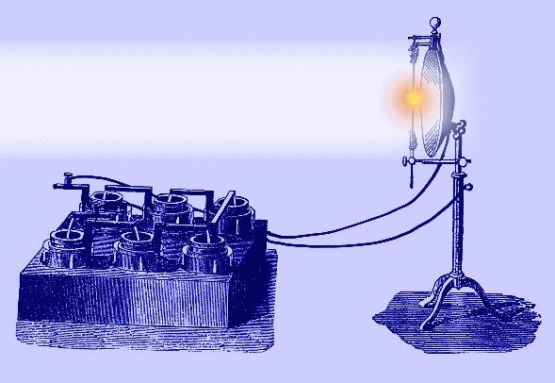
The written word, however, of their methods has survived only sparsely by comparison, this being due to three causes: first, the illiteracy of the craftsmen; secondly, the habit of all Guilds to conceal their methods by the use of cryptic expressions; and thirdly, the close guarding of secrets, which were frequently handed down from father to son by word of mouth.
Furthermore, artisans using oil-fired lights could have never completely removed the soot from the ceilings and walls after finishing their tasks because they would have had to clean up the smudge with the same smoke-belching lights that produced it. So how else, other than with the use of clean-burning electric lamps, could they have managed to meticulously decorate about 400 underground grave systems with no trace of any smoke residue?
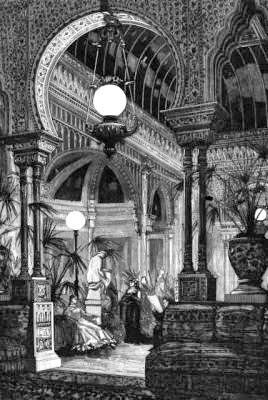
Furthermore, he also claimed no storm or rain extinguishes it.
It certainly does, and even more so if we consider what some renowned Egyptologists observed and some of the astonishing ancient lighting testimony that cannot be easily explained otherwise.
He found that the silversmiths of Bagdad use a primitive method of electroplating their wares. The origin of their method cannot be ascertained and seems to date back a number of years. Since galvanic batteries of the type found would generate a sufficiently powerful current for electrogilding small articles fashioned of silver, it might very well be that the origin of the method has to be sought in antiquity.[ii]
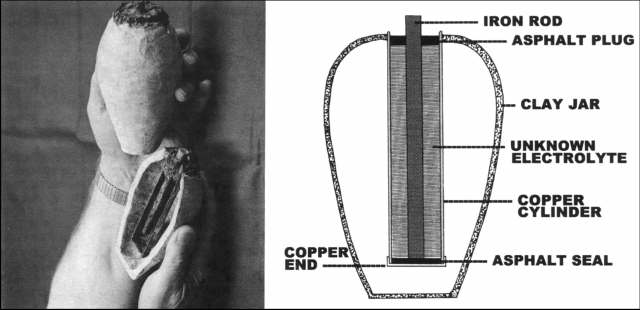
Several writers have suggested that the ancient Egyptians illuminated their tombs by reflecting rays of sunlight with an arrangement of mirrors.
However, the ancients probably did not need to rely on any natural source of sulfuric acid for the electrolyte in their batteries.
The ancient Greek kings ruling that city may well have relied on similar types of thermopiles to charge powerful lead-acid batteries hooked to the arc light on the Pharos lighthouse, an essential element for shipping safety and the citys commercial survival.
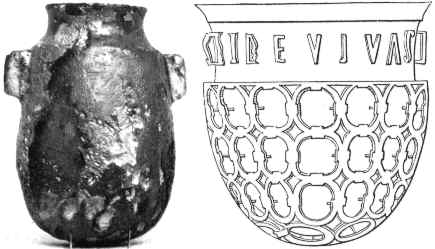
They likely, as today, relied on their ingenuity to manufacture their own.
In all freshly-opened tombs there are no traces whatever of any kind of combustion having taken place, even in the inner-most recesses. So strikingly evident is this that my friend M. Bouriant, while we were discussing this matter at Thebes, laughingly suggested the possibility that the electric light was known to the ancient Egyptians.[x]
They could never have succeeded with the light from dim candles, sloppy oil lamps, or smoky torches that would have starved them of essential oxygen and left unsightly soot marks clinging all over the tomb walls and ceilings.
TheGlcher Thermopile, being more convenient, less costly, and cleaner than primary batteries, was a popular means of charging storage batteries in the nineteenth century.
TheCatholic Encyclopedia[xvi]gives us a little background on his marvelous report – as follows:
However, sinceLuciancalled the lamp a stone, perhaps it was the only way he knew how to describe carbon, the carbon of a simple electric arc lamp.
In the Seventeenth Century B.C. we have a text of outstanding importance for the history of Chemistry in a tablet written by a glass-maker. Later on, in the Seventh Century, we have a collection of glass recipes made at the instance of King Ashurbanipal (668 – 626 B.C.).
An Edison or Lalande battery, a powerful primary electric cell
But that the ancient Sumerians had a very practical knowledge of chemical methods even before the invention of writing, let us say, very early in the Fourth Millennium B.C., is to be inferred from the beautiful gold work found by SirLeonard Wooleyat Ur, and the copper and bronze castings found throughout Southern Mesopotamia.
She bears on her head a stone called a lamp, and it receives its name from its function. That stone shines in the night with great clarity and provides the whole temple with light, as with [oil] lamps. In the daytime, it shines dimly, but has a very fiery aspect.[xiii]
can be produced in a vacuum, and below the surface of water, oils, and other non-conducting liquids, and it is thus quite independent of the action of the air.[xv]
There are few examples of rock architecture in Egypt more pleasing than this admirably proportioned, spotlessly white sepulcher of one who as governor of Akhenaton ranked as head of the notables. It is cut in the limestone cliffs that form a semicircle round the plain of Tell el-Amarna.[xii]
An assembly of this kind cannot very well have any other purpose than that of generating a weak electric current. If one remembers that it was found among undisturbed relics of the Parthian Kingdom – which existed from 250 B.C. to 224 A.D. – one naturally feels very reluctant to accept such an explanation, but there is really no alternative.
They seem to clearly portray electric carbon arc searchlights and filament bulbs. Priests apparently used them to illuminate the temple as well as various tombs – and more importantly, the mightyPharos Lighthouse. SoM. Bouriants casual suggestion that the ancient Egyptians may have employed electric lights is no longer a laughing matter.
There was, and still is, a temple of Venus, in which a lamp burns so strongly in the open air that no storm or rain extinguishes it.
Electric searchlights nightly lit up Jerusalem then, and a substantial portion of it at that, by casting their beams a great distance from another holy edifice – the circularChurch of the Ascensionon the Mount of Olives.
It could easily illuminate bright electric lights and also deliver a lethal dose of energy! In 1893, Dr. Girauds Thermo-electric stove, 3 feet high and 20 inches in diameter and fired by coal, not only could charge batteries but could also light several electric lamps, as well as heat a room 21 feet square. It was an expensive unit to build but cost would have been no obstacle for a wealthy ruler of any ancient city like Alexandria.
Carbon arc searchlights in a Denderah temple crypt
Now that we have established that the ancients also possessed all of these chemicals, includingSal Ammoniacandsulphuric acid, which are excellent battery-making materials, we need to look at least one example of a primary and second type of powerful battery that they could have easily produced to energize their ancient electric lights.
Similar batteries were also found in the vicinity of Bagdad in the ruins of a somewhat younger period. An expedition headed by Professor Dr.E. Khnel, who is now director of theStaatliches Museum in Berlin, discovered very similar vases with copper and iron parts, at Ktesiphon – not far from Bagdad. These finds date from the time when the dynasty of the Sassanides ruled Persia and the neighboring countries – 224 A.D. – 651 A.D.
With regards to ancient zinc,Rene Noorbergen, pointed out:
A Sargon II (722-705 BC) era glass jug and first century transparent glass vase
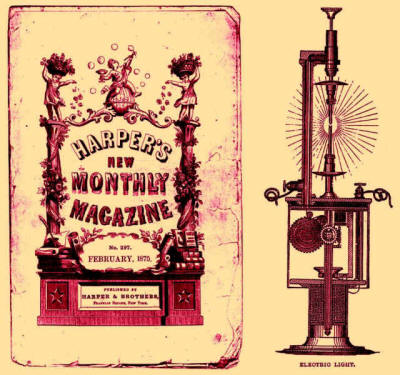
The caustic soda air cell has an open circuit voltage of 1.35 to 1.45 and an operating voltage even on comparatively heavy drains above 1.0 volt – perhaps 0.4 to 0.5 volt higher than that of a standard copper oxide cell. The carbon electrode can be used repeatedly, only zinc and electrolyte requiring renewal each time the cell is completely discharged.[vii]
More generally we have a large collection of medical texts which allow us to identify numerous substances in use during the First Millennium B.C. Finally I must mention numerous Sumero-Assyrian dictionaries which give lists of chemical words, also dating from the same period.
A Simple low-voltage electric cell and a simple electroplating bath and procedure
He was hospitably received by Adamnan, the abbot of the island monastery of Iona, to whom he gave a detailed narrative of his travels to the Holy Land, with specifications and designs of the sanctuaries so precise that Adamnan, with aid from some extraneous sources, was able to produce a descriptive work in three books, dealing with Jerusalem, Bethlehem, the principal towns of Palestine, and Constantinople.
Wilkinsons observation reminds us of what the prominent astronomer SirJ. Norman Lockyer, who also studied ancient Egyptian temples and tombs in depth, noticed in 1894.
In his editorial titled A Shocking Discovery, in a 1963 edition of the prestigiousJournal of the Electrochemical Society, he also added:
Nevertheless, for readers who are not familiar with the discovery of these ancient electric cells, we will call on the German rocket scientistWilly Leyto update us.
Electric batteries, 2000 years ago!!! Surprised? No need to be, really, declaredWillard F. M. Gray, an electrical engineer for General Electric.
In a 1939 article inAstounding magazine, he wrote:
In 1968, Dr.Koriun Megurtchianof the Soviet Union unearthed what is considered to be the oldest large-scale metallurgical factory in the world at Medzamor, in Soviet Armenia. Here, 4,500 years ago, an unknown prehistoric people worked with over 200 furnaces, producing an assortment of vases, knives, spearheads, rings, bracelets, etc.
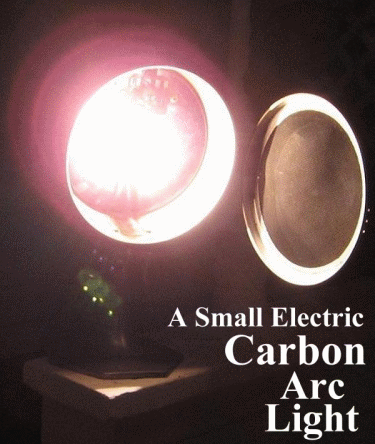
He blamed the reality of this marvelous lamp, likely an electric arc light, on the miracles of the black arts performed by demons and men [the illuminati].
An animated photo of ancient electric lights in a Denderah crypt
paintings offer few representations of lamps, torches, or any other kind of light.[viii]
In the course of the excavation of the Agora in Athens, a roll of sheet zinc, 98% pure, was supposedly found in a sealed deposit dating from the 3rd or 2nd century B.C. Fragments of a zinc coffin was reported to have fairly recently been discovered in Israel, which, judging by an artifact found nearby, dates back to 50 B.C.
The Medzamor craftsmen wore mouth-filters and gloves while they labored and fashioned their wares of copper, lead, zinc, iron, gold, tin, manganese and fourteen kinds of bronze. The smelters also produced an assortment of metallic paints, ceramics and glass.[iii]
Deep, dark tombs like this one would have required an electric light to illuminate them enough for ancient artisans to have embellished their walls with the correctly colored and finely detailed images of the deceaseds life.
Speaking of the ancient Assyrians (of Iraq) and the chemicals they produced by 650 B.C., in a paper read before theSociety for the Study of Alchemy and Early Chemistry, DoctorReginald Campbell Thompson, the author ofA Dictionary of Assyrian Chemistry and Geology, informs us that:

The center of the plug was formed by a solid piece of iron – now 75 millimeters long and originally a centimeter or so in diameter. The upper part of the iron rod shows that it was at first round, and while the lower end has partly corroded away so that the rod is pointed now at the lower end, it might be safely assumed that in the beginning it was of uniform thickness.
Clothes were cleansed in antiquity, according toCharles Singer, by lye from natron or wood-ash,[iv]so it was available for use as an electrolyte to activate powerful electric cells in antiquity.
In anEncyclopaedia Britannicaarticle published in 1929,G. W. Heise, a research chemist at theNational Carbon Company of Cleveland, Ohio, and an author of numerous articles in technical journals, explained the heavy-duty characteristics of this primary battery – which would certainly qualify it for carbon arc light usage in the searchlight on the ancientPharos Lighthouse.
With reference to the remarkable cleanliness of one particular ancient Egyptian tomb, Dr.F. L. Griffith,Professor of Egyptology at the University of Oxford, in an article entitled The Religious Revolution in Egypt, wrote:
We add to that inextinguishable lamp a host of other marvels of human and of magical origin – that is miracles of the demons black arts performed by men, and miracles performed by the demons themselves. If we choose to deny the reality of these, we shall ourselves be in conflict with the truth of the sacred books in which we believe.
The genera so far known to furnish this secretion are Dolium, Cassis, Tritonium, Cassidaria, Pleurobranchidium, Pleurobranchus, and Doris. The precise object of this secretion is not entirely understood, although it is suggested that it is used in perforating the bivalve shells or other mollusca which serve as article of food.[v]
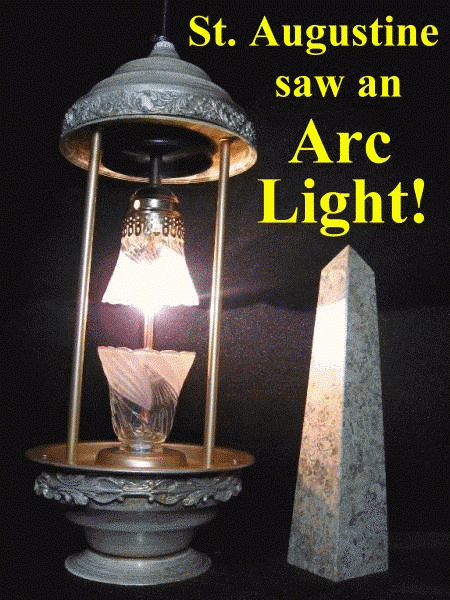
Electrogildingor electroplating basically only requires rods or wire, a couple of simple electric cells (batteries) connected to a bath of common chemicals wherein the items to be electroplated are placed.
Carbon arc lights hanging in a 19th-century French Hotel
Thus, either human ingenuity has devised in that inextinguishable lamp some contrivance based on the asbestos stone or else it was contrived by magic art to give men something to marvel at in that shrine; or perhaps some demon presented himself there under the name of Venus with which such effect that this prodigy was displayed to the public there and continued there for so many years.[xiv]
It is quite independent of the action of the air.
An animated picture of the Pharos Lighthouse
One example of a powerful primary battery that the ancients could have manufactured, using caustic soda or some equivalent, isthe Lalande Battery.
A carbon arc light popular in the 19th century, illustrated in the issue 1875 issue above
Carbon arc searchlights beaming out of the Electric Building at Chicagos 1893 Exposition
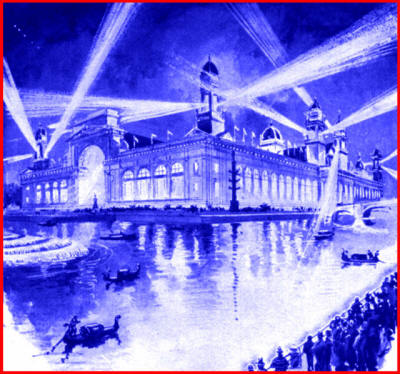
In the second century, a Syrian temple sheltered a statue of a goddess with one of these types of lights mounted on her head.
The extensive proofs provided inThe Electric Mirror on the Pharos Lighthouse and Other Ancient Lighting[xi]clearly demonstrate that possibility.
Beside all this common sense that strongly supports the need for ancient electric lighting stands several outstanding examples of ancient testimony that cannot be reasonably explained in any other way.
A railroad signal light sending directions down the track, like the Pharos flashed it messages over the sea, certainly demanded their periodic renewal, but eventually a more practical and economical source of illuminating power, the lead-acid secondary storage battery took its place.
A couple of centuries later, in hisCity of God, St. Augustine (354 – 430 A.D.) pointed out that in Egypt,
This quaint publication, which often serves as an excellent source of rare historical information, related:
And, since he said it had a very fiery aspect in the daytime, this makes us think that it might have been some kind of fiery carbon arc light – like those used to illuminate nineteenth-century cities and to power searchlights.
Of course, some tombs now show soot marks left from the oil lights of grave robbers who had previously violated them – butLockyerspoke of freshly-opened tombs.
This secretion from different mollusca, carefully analyzed, showed a considerable percentage of free sulphuric acid, some of combined sulphuric acid, combined chlorohydric acid, with potassa, soda, magnesia, and other substances; the glands secreting the liquids constituting from 7 to 9 per cent of the total weight of the animal. With this acid secretion there is, at least in some species, an evolution of pure carbonic gas, one gland, weighing approximately about 700 grains, yielding 206 cubic centimeters.
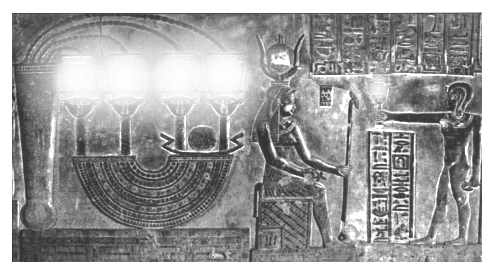
Lead-acid storage cells will produce a voltage of about 2 volts each, and the ancients could have easily connected several of them in series and parallel to create a powerful battery. Hooking its poles up to a couple of chunks of carbon from the remnants of a wood fire, touching the two together, and separating them a certain short distance will ignite a brilliant arc of light.
That is childs play. And it would not have taken long for them to realize that maintaining that distance will sustain a brilliant carbon arc light – the kind that would eventually be reflected from the huge mirror on the Pharos Lighthouse.
Manmade sulfuric acid(sulphuric acid) has been around at least since the seventh century B.C., and natural sulfuric acid has been available to use as an electrolyte for countless years before then.
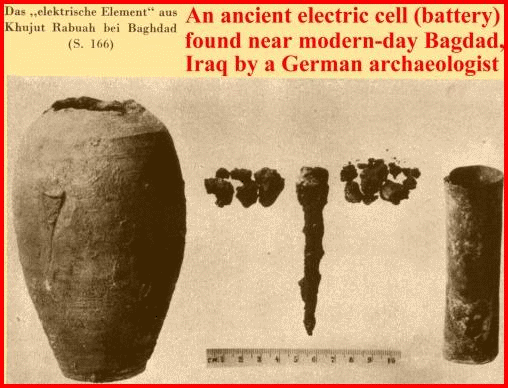
An animated illustration of a simple battery powered searchlight or electric mirror
In hisDawn of Astronomy, he brought attention to an enigma, at the time, when he pointed out:
An article inHarpers New Monthly Magazine, under the title of Secretion of Sulfuric Acid by Mollusks, points to where both modern and ancient man could have obtained natural sulfuric acid.
Writing at the time,Lucian of Samosataon theEuphratessays:
We already know the ancients manufactured primary cells, like the Baghdad batteries, that serve the purpose, but they could have easily used a thermo-electric generator, which is a simple device to make.
This points to the carbon in an arc light receiving its fire from an electric source – an ancient battery – not its own.
While the probable date of the invention is entirely open to conjecture, it seems likely that it was made in or near Bagdad, since all known finds were made in the vicinity of this city. It must be assumed, of course, that the subjects of the Sassanides had some use for them, and Dr. Koenig, the discoverer of the best preserved of all these vases, suggests that this use might still be in evidence in Bagdad itself.
However, light-absorbing mirrors are not a good option for pressing and complex projects demanding more than the Suns periodic appearance – in cloudless, dust-free, daylight skies.
Bronze Age peoplemade glass around 3,000 B.C., and the Egyptians manufactured glass beads about 2,500 B.C. Later, Alexandrians manufactured modern types of glass, during the Ptolemaic period – when the Pharos Lighthouse rose up.
Felix LalandeandGeorges Chaperonused a similar electrolyte to produce their primary battery in the nineteenth century, and it supplied enough current to power electric railroad lights for many days before it needed to be restored. Likewise, several large Lalande cells placed in series and parallel could have supplied enough voltage and current to power bright lights in antiquity for a long time before any of the batterys elements would have needed replacing.
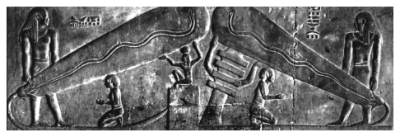

Air cells of the Lalande type, in which a porous carbon accessible to air is substituted for the usual copper oxide element, are also feasible. These have an even more horizontal discharge curve than the copper oxide cell, since the potential of the cathode remains virtually unchanged during service life.
These so-calledBaghdad batteries, discovered in the 1930s, are now old news, and the evidence that the ancients used them to electroplate some of the artifacts stored in museums around the world is likewise common knowledge.
This obviously seems like some type of electric light since Lucian clearly called the stone a lamp – and it was powerful enough to light up the whole temple. Furthermore, an electric light, any type for that matter, typically shines brightly at night and very dimly in the daytime.
A replica and diagram of one of the ancient electric cells (batteries) found near Bagdad
Thischurch fatheralso claimed that the,
is a retired broadcast engineer, an amateur radio operator (KB3ZU), and a graduate of the University of the State of New York. He has written several magazine articles as well as a few books. Historical Evidence for Unicorns and Astronomical Revelations or 666 were published in the mid 1990s and his latest release, in 2006, is The Electric Mirror on the Pharos Lighthouse and Other Ancient Lighting. It may be ordered by clicking:
This also points to the electric arc light becauseChambers Encyclopaediamaintains that it,
Beside this, the maze of rooms in some tombs would have caused insurmountable problems for technicians trying to keep a large number of mirrors critically aligned and continuously tracking one another as they tried to catch and bounce around the diminishing rays of our elusive sun. Moreover, some technician or artisan confined in a complex Egyptian tomb would have eventually stepped in front of one of the reflectors and have broken a critical link in the intricate chain of light – abruptly leaving others down the line struggling in total darkness.
The inner surface of this round copper sheet – the one that formed the inner bottom of the hollow cylinder – was covered with a layer of asphalt, 3 millimeters in thickness. A thick, heavy plug of the same material was forced into the upper end of the cylinder.
Occasionally, we feel a bit smug about our tremendous advances in the nuclear science and the like, but when we are scooped by some ancient metal smiths we are most assuredly brought down to earth and humbled. It will ever be so.[i]
A couple of hundred years later,carbon arc light technologystill survived.
St. Bede relates (Hist. Eccles. Angl., V, 15) that Arculf, on his return from a pilgrimage to the Holy Land about 670 or 690, was cast by tempest on the shore of Scotland.
The ancients had access to all of these materials:
Prehistoric mansmelted Lead. One old piece of lead work in the British Museum dates back to 3,800 B.C. Several millenniums later, Romans were using it at length in their cooking pots, tankards, and plumbing; and many probably poisoned their brains in the process. The resulting insanity may have eventually contributed to the fall of the empire.
Because it requires no attention for long periods of time and because of its excellent continuous discharge and heavy-duty characteristics, the Lalande cell is at present much used in railway signal operation. It can be made in dry or non-spillable form either by gelatinizing the caustic soda solution with small quantities of starch or by using such expedients as making a paste out of electrolyte and magnesium oxide.
The remarkable fact was announced some years ago that certaingastropod molluscasecrete free sulfuric acid; and this has since then been not infrequently observed in the case of the giganticDolium galea, which discharges from its proboscis a drop of liquid or saliva that produces a very sensible effervescence on chalk or marble.
They merely had to heat one of two dissimilar metallic conductors joined together, like copper and iron, to create a thermo-electric generator, which is also called a thermopile and thermo-electric stove.
This type of battery needs no external source of electricity to revitalize it. After it has discharged, replacing some of its internal ingredients restores the unit to full capacity.
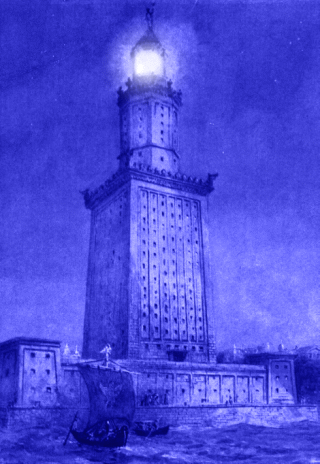
The Lalande cell is one of the most efficient and satisfactory primary batteries known today for the special classes of service to which it is suited. It lends itself readily to rugged construction; it is relatively cheap to make and operate; it is very reliable in its action and has a high current output per unit of volume (about 1 ampere hour per 8 cc. of electrolyte). The cell is made in units as large as 500 to 1,000 ampere hour sizes.
The circular opening at the top of the vase had a diameter of 33 millimeters. Inside of this vase a cylinder made of sheet copper of high purity was found – the cylinder being 10 centimeters high and having a diameter of about 26 millimeters, almost exactly 1 inch.
SirJohn Gardner Wilkinson(1798 – 1875), a distinguished nineteenth-century Egyptologist, pointed out that the ancient Egyptian,
This work also includes excellent reproductions of the extraordinary ancient illustrations discovered on the crypt walls beneath theTemple of Hathor (Isis) at Denderah.
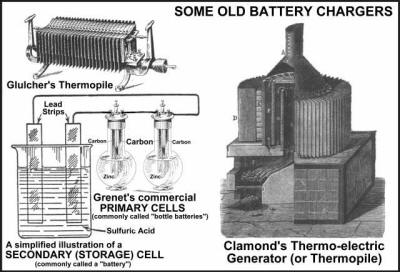
Dr.Wilhelm Koenigof theIraq Museum in Bagdadreported recently that a peculiar instrument was unearthed by an expedition of his museum in the summer of 1936. The find was made at Khujut Rabua, not far to the southeast of Bagdad. It consisted of a vase made of clay, about 14 centimeters high and with its largest diameter 8 centimeters.
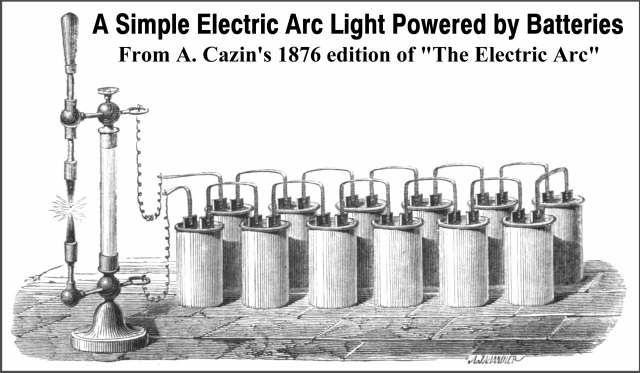
There were some pretty smart metal workers in the ancient city of Baghdad, Persia [now Iraq]. They did a lot of fine work in steel, gold, and silver. You may wonder what this had to do with electric batteries. It seems that copper vases, some of whose ages go back 4000 years, were unearthed several years ago which had designs plated on them in gold or silver, even some were plated with antimony.
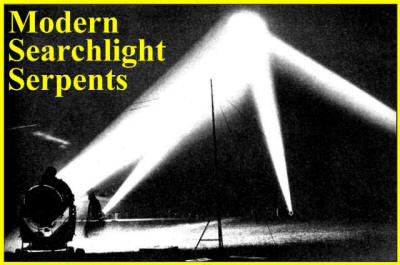
It gave on a short circuit about 5 amperes of current at 4 volts. However, this thermo-electric generator hardly compared to the power output of the improvedClamond Thermopileof 1879, which produced 109 volts, with an internal resistance of 15.5 ohms.
